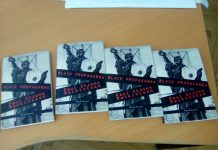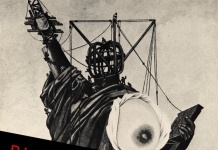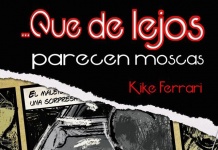 Laird Barron is approaching iconic status in the horror and dark fiction community with almost frightening speed. How many other living authors get a tribute anthology paying homage to their aesthetic when they’re only just into their fourth book? Anyone who is waiting for the bubble to burst, however, is probably going to have to sit around for quite a while longer. At least if Occultation and Other Stories is anything to go by.
Laird Barron is approaching iconic status in the horror and dark fiction community with almost frightening speed. How many other living authors get a tribute anthology paying homage to their aesthetic when they’re only just into their fourth book? Anyone who is waiting for the bubble to burst, however, is probably going to have to sit around for quite a while longer. At least if Occultation and Other Stories is anything to go by.
This volume of nine stories, with an introduction by the much-missed Michael Shea, won the 2010 Shirley Jackson Award for a Single-Author Collection, just as his first collection, The Imago Sequence and Other Stories, won the 2007 inaugural Award. Several of the individual stories themselves have also been prize winners or nominees. I won’t wheel out the cliche that they show a greater deepening and maturity in Barron’s work, because some at least were the same vintage as The Imago Sequence – plus, it’s hard to imagine much improvement on that staggering start. If there is any discernible shift, perhaps it’s that more of the characters appear to end up absorbed or claimed by the dark forces in the stories than are defeated or devoured by them, but that could be just an artifact of the arrangement rather than a path of development. And they definitely are even morer and betterer.
There is plenty of variety, though. This collection shows how very much more there is to the author than the “Carnivorous Cosmos” tag, which is rapidly becoming a defining cliche. For one thing, for any readers expecting more two-fisted whisky-swilling protagonists squaring off against the Unknown with their trusty Krag, Barron demonstrates herein that, just like Melvin Udall, he writes women very well, as in “The Lagerstätte,” “Catch Hell,” or “Occultation” itself, or gay leads, as in “Mysterium Tremendum” or “Strappado.” There is also a range from what might also be psychological horror, as in the murderous artistes of “Strappado,” to the utterly arcane, taking in along the way a very penetrating and sympathetic eye for character and local detail, as in “The Broadsword” or “Catch Hell.” The flavor and imaginative sense of place in these tales is as rich as any sod of Washington State forest earth. Also, “Mysterium Tremendum” and “The Broadsword” both contain some of Barron’s most explicitly mapped-out threats/nemesises/eldritch eruptions along traditional Lovecraftian lines, rather the shadowy enigmas in some of his other stories, but even such overt and clearly drawn menaces manage to be deeply unsettling. Indeed, there’s perhaps a tendency in many of the tales to employ less indirection and fewer evocative hints about the dangers and pitfalls, but few readers are going to feel any the less completely creeped out.
I’d evoke another shade for a moment here, that of Robert E. Howard, but to throw up another overshadowing cliche that Barron is struggling to outgrow. Rather, it’s to cite another author who wrote voluminously, with a pulpish flair, but also to a consistently high standard and with far-reaching imagination. Barron looks well on track to do the same – but it’s a tortuous and very dark forest track. Follow it at your thrilling peril.
TeleRead rating: 4.5 out of 5

































